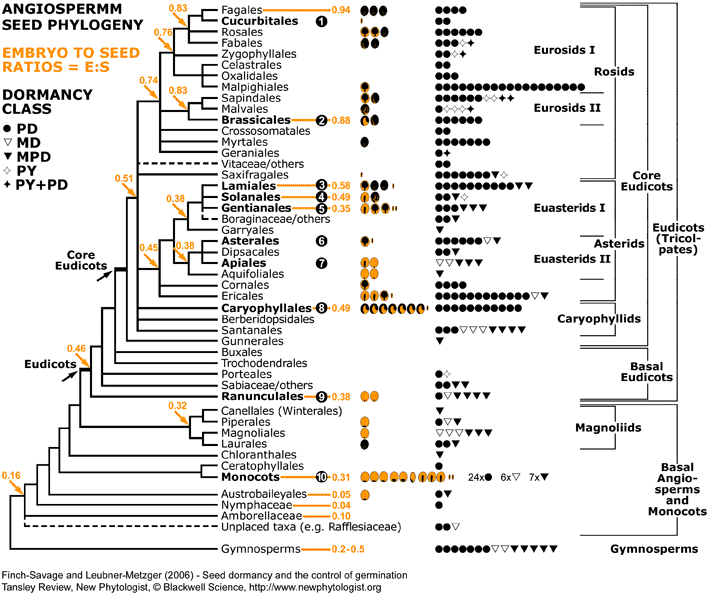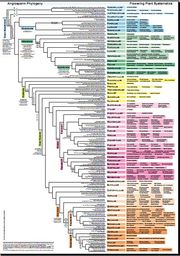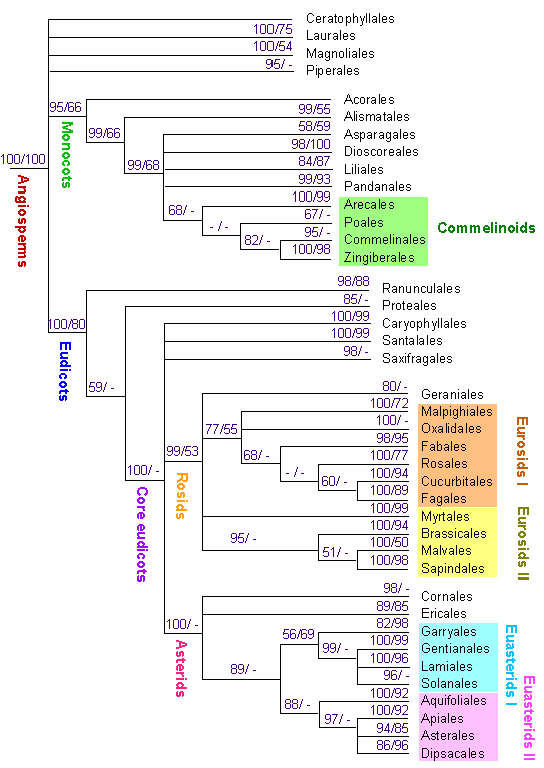Angiosperm Phylogeny Group
The Angiosperm Phylogeny Group was a group of botanists led by Mark Chase, who worked together on the phylogeny of the angiosperms. The group has published from 1998 to 2009 three classifications that quickly prevailed against older classifications. The final publication of 2009, APG III, superseded all previous drafts of the APG.
Chase took already in the 1980s to work on, but first attempts failed due to insufficient performance computer technology. Only in 1993 could start with data collection, the Angiosperm Phylogeny Group then baptized workgroup. In 1995, before sufficient amounts of data to start an evaluation that led to the first publication in 1998. APG was led by Mark Chase part of the Kew Gardens, further in the project, the University of Stockholm, the Stockholm Bergius Botanical Garden, the University of Florida, the University of Maryland and the Missouri Botanical Garden. Were
The group's work focuses on the orders and families, higher ranks replaced by informal groups, such as monocots, Rosids, Asterids or Commelin ( o) ids that may present monophyletic groups, but no taxa. Genera or species are found only occasionally mention. As the basis of the results of phylogenetic classifications were works that were mostly obtained on the basis of molecular genetic studies. They were quick to reference and standard works and textbooks, such as Strasburger (36th Edition), the " evolutionary biology " von Storch, Welsch, Wink or the 2nd Edition by Thomas N. Taylor, inter alia, " Paleobotany. The Biology and Evolution of Fossil Plants " from 2008.
In two other publications in 2003 and 2009, the classification was further updated and improved. The third publication, the project ended.
- 2.1 Unallocated
- 2.2 Magnoliids
- 2.3 Monocots
- 2.4 eudicots
- 3.1 Magnoliids
- 3.2 Monocots 3.2.1 Commelinids
- 3.4.1 Core Eudikotylen 3.4.1.1 Rosids clade 3.4.1.1.1 € Siden I ( Fabids )
- 3.4.1.1.2 € Siden II ( malvids )
- 3.4.1.2.1 Asterides I ( lamiids )
- 3.4.1.2.2 Asterides II ( campanulids )
APG classification
The first classification of angiosperms APG was released in 1998 under the title An Ordinal Classification for the Families of Flowering Plants and included 462 families in 40 orders. Authors were Arne A. Anderberg, Anders Backlund, Birgitta Bremen, Bremen Kåre, Barbara G. Biggs, Mark W. Chase, Peter K. Endress, Michael F. Fay, Peter Goldblatt, Mats HG Gustafsson, Sara B. Hoot, Walter S. Judd, Mari Källersjö, Elizabeth A. Kellogg, Kathleen A. Kron, Donald H. Les, Cynthia M. Morton, Daniel L. Nick Rent, Richard G. Olmstead, Robert A. Price, Christopher J. Quinn, James E. Rodman, Paula J. Rudall, Peter F. Stevens, Vincent Savolainen, Douglas E. Soltis, Pamela Soltis E., Kenneth J. Sytsma and Mats Thulin.
This design was the modification of a system that had been published by Kåre Bremer, Birgitta Bremer and Mats Thulin in the first three editions of their phylogeny and systematics of Introduction to flowering plants from 1995 to 1997 and can also be found on the internet since 1996.
Not assigned
- ( No Name) No order classification
- Ceratophyllales
- Piperales
Monocots
- ( No Name) No order classification
- Kalmusartige ( Acorales )
- Frog -spoon-shaped ( Alismatales )
- Asparagales ( Asparagales )
- Yamswurzelartige ( Dioscoreales )
- Lily behaved ( Liliales )
- Tree-like screws ( Pandanales )
- No order classification
- Palm -like ( Arecales )
- Commelina behaved ( Commelinales )
- Süßgrasartige ( Poales )
- Ginger -like ( Zingiberales )
Dicots
- Non -core eudicots No order classification
- Buxales
- Ranunculales
- No order classification
- Santalales
- No order classification
- No order classification
- Fagales
- No order classification
- Myrtales
- No order classification
- Gentianales
- Solanales
- No order classification
- Asterales
- No order classification
APG II classification
The APG II in 2003 updated the publication of 1998. Changes were manageable, mostly unassigned taxa were only previously placed. The system consisted of 457 families in 45 orders. Authors were Arne A. Anderberg, Birgitta Bremer, Kåre Bremer, Mark W. Chase, Michael F. Fay, Peter Goldblatt, Walter S. Judd, Mari Källersjö, Jesper Kårehed, Kathleen A. Kron, Johannes Lundberg, Daniel L. Nick Rent, Richard G. Olmstead, Bengt Oxelman, J. Chris Pires, James L. Reveal, James E. Rodman, Paula J. Rudall, Douglas E. Soltis, Pamela S. Soltis, Peter F. Stevens, Vincent Savolainen, Kenneth J. Sytsma, Michelle van der Bank, Kenneth Wurdack, Jenny Q.-Y. Xiang and Sue Zmarzty.
Not assigned
- Family Amborellaceae
- Family Chloranthaceae
- Family Nymphaeaceae [ Family Cabombaceae ]
Magnoliids
- Order Canellales
- Order Laurales
- Order Magnoliales
- Order Piperales
Monocots
- Family Petrosaviaceae
- Family Dasypogonaceae
Eudicots
- Family Buxaceae [ Family Didymelaceae ]
- Family Sabiaceae
- Family Trochodendraceae [ Family Tetracentraceae ]
- Family Aextoxicaceae
- Family Berberidopsidaceae
- Family Dilleniaceae
- Family Aphloiaceae
- Family Geissolomataceae
- Family Ixerbaceae
- Family Picramniaceae
- Family Strasburgeriaceae
- Family Vitaceae
- Order Crossosomatales
- Order Geraniales
- Order Myrtales
- Family Zygophyllaceae [ Family Krameriaceae ]
- Family Huaceae
- Family Tapisciaceae
- Order Cornales
- Order Ericales
- Family Boraginaceae
- Family Icacinaceae
- Family Oncothecaceae
- Family Vahliaceae
- Family Bruniaceae
- Family Columelliaceae [ Family Desfontainiaceae ]
- Family Eremosynaceae
- Family Escalloniaceae
- Family Paracryphiaceae
- Family Polyosmaceae
- Family Sphenostemonaceae
- Family Tribelaceae
APG III Classification
The final classification, APG III was - also as an upgrade - announced for 2007/2008 and should bring only small changes compared to APG II. Then you only appeared in October 2009, the main authors were Birgitta Bremer, Kåre Bremer, Mark W. Chase, Michael F. Fay, James L. Reveal, Douglas E. Soltis, Pamela S. Soltis and Peter F. Stevens. APG III solved largely on the sometimes uncertain assignments of the previous versions, leaving only a few taxa unplaced. Compared to its predecessor, the number of unplaced taxa has reduced to 2 families and three genera, in return, there were 14 new orders.
In the course of five international workshops, which were organized in 2008 by David Mabberley during the preparations for the third edition of " Mabberley 's Plant -book ", previously introduced by the APG I and II proposal " stapled taxa " ( " bracketed taxa " ) was discussed. This bracketed taxa allowed to propose a family in two versions, namely once in a comprehensive and in a split into several families version. This should be in cases where the state of research was inconclusive, leave scope for individual preferences. As a result of these discussions, a meeting of experts from herbaria was waived in APG III such as perceived uncomfortable alternative versions in favor of families in their respective broader version.
- Amborellales Amborellaceae
- Cabombaceae
- Hydatellaceae
- Nymphaeaceae
- Austrobaileyaceae
- Schisandraceae
- Trimeniaceae
- Chloranthaceae
Magnoliids
- Canellales Canellaceae
- Winteraceae
- Aristolochiaceae
- Hydnoraceae
- Lactoridaceae
- Piperaceae
- Saururaceae
- Atherospermataceae
- Calycanthaceae
- Gomortegaceae
- Hernandiaceae
- Lauraceae
- Monimiaceae
- Siparunaceae
- Annonaceae
- Degeneriaceae
- Eupomatiaceae
- Himantandraceae
- Magnoliaceae
- Myristicaceae
Monocots
- Acorales Acoraceae
- Alismataceae (including Limnocharitaceae )
- Aponogetonaceae
- Araceae
- Butomaceae
- Cymodoceaceae
- Hydrocharitaceae
- Juncaginaceae
- Posidoniaceae
- Potamogetonaceae
- Ruppiaceae
- Scheuchzeriaceae
- Tofieldiaceae
- Zosteraceae
- Petrosaviaceae
- Burmanniaceae
- Dioscoreaceae
- Nartheciaceae
- Cyclanthaceae
- Pandanaceae
- Stemonaceae
- Triuridaceae
- Velloziaceae
- Alstroemeriaceae (including Luzuriagaceae )
- Campynemataceae
- Colchicaceae
- Corsiaceae
- Liliaceae
- Melanthiaceae
- Petermanniaceae
- Philesiaceae
- Rhipogonaceae
- Smilacaceae
- Amaryllidaceae (including Agapanthaceae, Alliaceae )
- Asparagaceae (including Agavaceae, Aphyllanthaceae, Hesperocallidaceae, Hyacinthaceae, Laxmanniaceae, Ruscaceae, Themidaceae )
- Asteliaceae
- Blandfordiaceae
- Boryaceae
- Doryanthaceae
- Hypoxidaceae
- Iridaceae
- Ixioliriaceae
- Lanariaceae
- Orchidaceae
- Tecophilaeaceae
- Xanthorrhoeaceae (including Asphodelaceae, Hemerocallidaceae )
- Xeronemataceae
Commelinids
- Dasypogonaceae
- Arecales Arecaceae
- Commelinaceae
- Haemodoraceae
- Hanguanaceae
- Philydraceae
- Pontederiaceae
- Anarthriaceae
- Bromeliaceae
- Centrolepidaceae
- Cyperaceae
- Ecdeiocoleaceae
- Eriocaulaceae
- Flagellariaceae
- Joinvilleaceae
- Juncaceae
- Mayacaceae
- Poaceae
- Rapateaceae
- Restionaceae
- Thurniaceae
- Typhaceae (including Sparganiaceae )
- Xyridaceae
- Cannaceae
- Costaceae
- Heliconiaceae
- Lowiaceae
- Marantaceae
- Musaceae
- Strelitziaceae
- Zingiberaceae
Probable sister group of Eudikotylen
- Ceratophyllales Ceratophyllaceae
Eudikotylen
- Ranunculales Berberidaceae
- Circaeasteraceae (including Kingdoniaceae )
- Eupteleaceae
- Lardizabalaceae
- Menispermaceae
- Papaveraceae (including Fumariaceae, Pteridophyllaceae )
- Ranunculaceae
- Nelumbonaceae
- Platanaceae
- Proteaceae
- Trochodendraceae
- Buxaceae
- Haptanthaceae
Core Eudikotylen
- Gunnerales Gunneraceae
- Myrothamnaceae
- Altingiaceae
- Aphanopetalaceae
- Cercidiphyllaceae
- Crassulaceae
- Daphniphyllaceae
- Grossulariaceae
- Haloragaceae
- Hamamelidaceae
- Iteaceae
- Pterostemonaceae
- Paeoniaceae
- Penthoraceae
- Peridiscaceae (including Medusandraceae, Soyauxia )
- Saxifragaceae
- Tetracarpaeaceae
- Aextoxicaceae
- Berberidopsidaceae
- Balanophoraceae
- Loranthaceae
- Misodendraceae
- Santalaceae
- Olacaceae
- Opiliaceae
- Schoepfiaceae
- Achatocarpaceae
- Aizoaceae
- Amaranthaceae
- Anacampserotaceae
- Ancistrocladaceae
- Asteropeiaceae
- Barbeuiaceae
- Basellaceae
- Cactaceae
- Caryophyllaceae
- Didiereaceae
- Dioncophyllaceae
- Droseraceae
- Drosophyllaceae
- Frankeniaceae
- Gisekiaceae
- Halophytaceae
- Limeaceae
- Lophiocarpaceae
- Molluginaceae
- Montiaceae
- Nepenthaceae
- Nyctaginaceae
- Physenaceae
- Phytolaccaceae
- Plumbaginaceae
- Polygonaceae
- Portulacaceae
- Rhabdodendraceae
- Sarcobataceae
- Simmondsiaceae
- Stegnospermataceae
- Talinaceae
- Tamaricaceae
Rosids clade
- Vitales Vitaceae
- Zygophyllales Krameriaceae
- Zygophyllaceae
- Celastraceae (including Lepuropetalaceae, Parnassiaceae, Pottingeriaceae )
- Lepidobotryaceae
- Brunelliaceae
- Cephalotaceae
- Connaraceae
- Cunoniaceae
- Elaeocarpaceae
- Huaceae
- Oxalidaceae
- Achariaceae
- Balanopaceae
- Bonnetiaceae
- Calophyllaceae
- Caryocaraceae
- Centroplacaceae
- Chrysobalanaceae
- Clusiaceae
- Ctenolophonaceae
- Dichapetalaceae
- Elatinaceae
- Erythroxylaceae
- Euphorbiaceae
- Euphroniaceae
- Goupiaceae
- Humiriaceae
- Hypericaceae
- Irvingiaceae
- Ixonanthaceae
- Lacistemataceae
- Linaceae
- Lophopyxidaceae
- Malpighiaceae
- Ochnaceae (including Medusagynaceae, Quiinaceae )
- Pandaceae
- Passifloraceae (including Malesherbiaceae, Turneraceae )
- Phyllanthaceae
- Picrodendraceae
- Podostemaceae
- Putranjivaceae
- Rafflesiaceae
- Rhizophoraceae
- Salicaceae
- Trigoniaceae
- Violaceae
- Anisophylleaceae
- Begoniaceae
- Coriariaceae
- Corynocarpaceae
- Cucurbitaceae
- Datiscaceae
- Tetramelaceae
- Fabaceae
- Polygalaceae
- Quillajaceae
- Surianaceae
- Betulaceae
- Casuarinaceae
- Fagaceae
- Juglandaceae (including Rhoipteleaceae )
- Myricaceae
- Nothofagaceae
- Ticodendraceae
- Barbeyaceae
- Cannabaceae
- Dirachmaceae
- Elaeagnaceae
- Moraceae
- Rhamnaceae
- Rosaceae
- Ulmaceae
- Urticaceae
- Geraniales Geraniaceae (including Hypseocharitaceae )
- Melianthaceae (including Francoaceae )
- Vivianiaceae (including Ledocarpaceae )
- Alzateaceae
- Combretaceae
- Crypteroniaceae
- Lythraceae
- Melastomataceae (including Memecylaceae )
- Myrtaceae (including Heteropyxidaceae, Psiloxylaceae )
- Onagraceae
- Penaeaceae (including Oliniaceae, Rhynchocalycaceae )
- Vochysiaceae
- Aphloiaceae
- Crossosomataceae
- Geissolomataceae
- Guamatelaceae
- Stachyuraceae
- Staphyleaceae
- Strasburgeriaceae (including Ixerbaceae )
- Picramniaceae
- Dipentodontaceae
- Gerrardinaceae
- Tapisciaceae
- Akaniaceae
- Bataceae
- Brassicaceae
- Capparaceae
- Caricaceae
- Cleomaceae
- Emblingiaceae
- Gyrostemonaceae
- Koeberliniaceae
- Limnanthaceae
- Moringaceae
- Pentadiplandraceae
- Resedaceae
- Salvadoraceae
- Setchellanthaceae
- Tovariaceae
- Tropaeolaceae
- Bixaceae (including Cochlospermaceae, Diegodendraceae )
- Cistaceae
- Cytinaceae
- Dipterocarpaceae
- Malvaceae
- Muntingiaceae
- Neuradaceae
- Sarcolaenaceae
- Sphaerosepalaceae
- Thymelaeaceae
- Anacardiaceae
- Biebersteiniaceae
- Burseraceae
- Kirkiaceae
- Meliaceae
- Nitrariaceae (including Peganaceae, Tetradiclidaceae )
- Rutaceae
- Sapindaceae
- Simaroubaceae
Asterides
- Cornales Cornaceae (including Nyssaceae )
- Curtisiaceae
- Grubbiaceae
- Hydrangeaceae
- Hydrostachyaceae
- Loasaceae
- Actinidiaceae
- Balsaminaceae
- Clethraceae
- Cyrillaceae
- Diapensiaceae
- Ebenaceae
- Ericaceae
- Fouquieriaceae
- Lecythidaceae
- Marcgraviaceae
- Mitrastemonaceae
- Pentaphylacaceae (including Ternstroemiaceae )
- Polemoniaceae
- Primulaceae (including Maesaceae, Myrsinaceae, Theophrastaceae )
- Roridulaceae
- Sapotaceae
- Sarraceniaceae
- Sladeniaceae
- Styracaceae
- Symplocaceae
- Tetrameristaceae (including Pellicieraceae )
- Theaceae
- Boraginaceae (including Hoplestigmataceae )
- Vahliaceae
- Icacinaceae
- Metteniusaceae
- Oncothecaceae
- Garryales Eucommiaceae
- Garryaceae (including Aucubaceae )
- Apocynaceae
- Gelsemiaceae
- Gentianaceae
- Loganiaceae
- Rubiaceae
- Acanthaceae
- Bignoniaceae
- Byblidaceae
- Calceolariaceae
- Carlemanniaceae
- Gesneriaceae
- Lamiaceae
- Linderniaceae
- Lentibulariaceae
- Martyniaceae
- Oleaceae
- Orobanchaceae
- Paulowniaceae
- Pedaliaceae
- Phrymaceae
- Plantaginaceae
- Plocospermataceae
- Schlegeliaceae
- Scrophulariaceae
- Stilbaceae
- Tetrachondraceae
- Thomandersiaceae
- Verbenaceae
- Convolvulaceae
- Hydroleaceae
- Montiniaceae
- Solanaceae
- Sphenocleaceae
- Aquifoliales Aquifoliaceae
- Cardiopteridaceae (including Leptaulas )
- Helwingiaceae
- Phyllonomaceae
- Stemonuraceae
- Alseuosmiaceae
- Argophyllaceae
- Asteraceae
- Calyceraceae
- Campanulaceae (incl. Lobeliaceae )
- Goodeniaceae
- Menyanthaceae
- Pentaphragmataceae
- Phellinaceae
- Rousseaceae
- Stylidiaceae (including Donatiaceae )
- Escalloniaceae
- Bruniaceae
- Columelliaceae (including Desfontainaceae )
- Paracryphiaceae (including Quintiniaceae )
- Adoxaceae
- Caprifoliaceae (including Diervillaceae, teasel, Linnaeaceae, Morinaceae, Valerianaceae )
- Apiaceae
- Araliaceae
- Griseliniaceae
- Myodocarpaceae
- Pennantiaceae
- Pittosporaceae
- Torricelliaceae (including Aralidiaceae, Melanophyllaceae )
Taxa of uncertain position
- Apodanthaceae
- Cynomoriaceae
- Gumillea
- Petenaea
- Nicobariodendron










